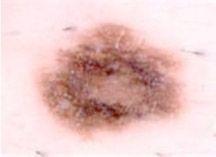DYSPLASTIC NEVUS
 Dysplastic nevus also referred to as atypical nevus or Clark’s nevus, is an acquired mole that may appear as solitary or multiple lesions. They are significant in that someone with a dysplastic nevus is considered to have an increased lifetime risk for melanoma. Dysplastic nevi are seen in about 4% of the Caucasian population in the United States. Some families have large numbers of dysplastic nevi as well as histories of melanoma. These people must be observed closely because their lifetime risk for Melanoma can be quite high.
Dysplastic nevus also referred to as atypical nevus or Clark’s nevus, is an acquired mole that may appear as solitary or multiple lesions. They are significant in that someone with a dysplastic nevus is considered to have an increased lifetime risk for melanoma. Dysplastic nevi are seen in about 4% of the Caucasian population in the United States. Some families have large numbers of dysplastic nevi as well as histories of melanoma. These people must be observed closely because their lifetime risk for Melanoma can be quite high.
The most common technique to remembering the signs and symptoms of dysplastic nevus is the acronym ABCDE:
-
Asymmetrical skin lesion
-
Border of the mole is irregular
-
Color varies from brown to tan or pink. Cracking, bleeding, and itching can also occur.
-
The diameter of the mole is greater than 6mm causing pain and sensitivity
-
Evolution of mole is a sign of malignancy
Treatment
-
Family members of a patient with a dysplastic nevus should be examined for evidence of the dysplastic nevus syndrome. Such individuals should avoid excessive sun exposure.
-
It is recommended that patients with atypical or dysplastic nevi have their skin examined on an annual basis.


